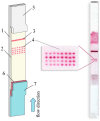Multiplex Lateral Flow Immunoassay: An Overview of Strategies towards High-throughput Point-of-Need Testing
- PMID: 30587769
- PMCID: PMC6468474
- DOI: 10.3390/bios9010002
Multiplex Lateral Flow Immunoassay: An Overview of Strategies towards High-throughput Point-of-Need Testing
Abstract
Simultaneous measurement of different substances from a single sample is an emerging issue for achieving efficient and high-throughput detection in several fields of application. Although immunoanalytical techniques have well-established and prevailing advantages over alternative screening analytical platforms, one of the incoming challenges for immunoassay is exact multiplexing. Lateral flow immunoassay (LFIA) is a leading immunoanalytical technique for onsite analysis, thanks to its simplicity, rapidity, and cost-effectiveness. Moreover, LFIA architecture is adaptable to multiplexing, and is therefore a possible answer to the pressing demand of multiplexing point-of-need analysis. This review presents an overview of diverse approaches for multiplex LFIA, with a special focus on strategies based on new types of magnetic, fluorescent, and colored labels.
Keywords: immunoassay; immunochromatographic test; point-of-care testing; rapid test.
Conflict of interest statement
The authors declare no conflict of interest.
Figures






Similar articles
-
Ten Years of Lateral Flow Immunoassay Technique Applications: Trends, Challenges and Future Perspectives.Sensors (Basel). 2021 Jul 30;21(15):5185. doi: 10.3390/s21155185. Sensors (Basel). 2021. PMID: 34372422 Free PMC article. Review.
-
Design of multiplexing lateral flow immunoassay for detection and typing of foot-and-mouth disease virus using pan-reactive and serotype-specific monoclonal antibodies: Evidence of a new hook effect.Talanta. 2022 Apr 1;240:123155. doi: 10.1016/j.talanta.2021.123155. Epub 2021 Dec 17. Talanta. 2022. PMID: 34942474
-
Evaluation of the Multidimensional Enhanced Lateral Flow Immunoassay in Point-of-Care Nanosensors.ACS Nano. 2024 Oct 8;18(40):27167-27205. doi: 10.1021/acsnano.4c06564. Epub 2024 Sep 23. ACS Nano. 2024. PMID: 39311085 Review.
-
Switching from Multiplex to Multimodal Colorimetric Lateral Flow Immunosensor.Sensors (Basel). 2020 Nov 18;20(22):6609. doi: 10.3390/s20226609. Sensors (Basel). 2020. PMID: 33218125 Free PMC article.
-
Simplified formats of modern biosensors: 60 years of using immunochromatographic test systems in laboratory diagnostics.Klin Lab Diagn. 2020 Sep 17;65(10):611-618. doi: 10.18821/0869-2084-2020-65-10-611-618. Klin Lab Diagn. 2020. PMID: 33245650 Review. English.
Cited by
-
Point-of-Care Monitoring of Respiratory Diseases Using Lateral Flow Assay and CMOS Camera Reader.IEEE J Transl Eng Health Med. 2022 Aug 10;10:2800208. doi: 10.1109/JTEHM.2022.3193575. eCollection 2022. IEEE J Transl Eng Health Med. 2022. PMID: 35992371 Free PMC article.
-
Six decades of lateral flow immunoassay: from determining metabolic markers to diagnosing COVID-19.AIMS Microbiol. 2020 Aug 26;6(3):280-304. doi: 10.3934/microbiol.2020018. eCollection 2020. AIMS Microbiol. 2020. PMID: 33134745 Free PMC article. Review.
-
Host blood protein biomarkers to screen for tuberculosis disease: a systematic review and meta-analysis.J Clin Microbiol. 2024 Nov 13;62(11):e0078624. doi: 10.1128/jcm.00786-24. Epub 2024 Oct 24. J Clin Microbiol. 2024. PMID: 39445833 Free PMC article.
-
Point-of-care detection of cytokines in cytokine storm management and beyond: Significance and challenges.View (Beijing). 2021 Aug;2(4):20210003. doi: 10.1002/VIW.20210003. Epub 2021 May 4. View (Beijing). 2021. PMID: 34766163 Free PMC article. Review.
-
Cost-effectiveness analysis of a multiplex lateral flow rapid diagnostic test for acute non-malarial febrile illness in rural Cambodia and Bangladesh.Lancet Reg Health Southeast Asia. 2024 Mar 16;23:100389. doi: 10.1016/j.lansea.2024.100389. eCollection 2024 Apr. Lancet Reg Health Southeast Asia. 2024. PMID: 38523864 Free PMC article.
References
-
- Dhawan A. Point-of-Care Technologies: An Evolution in Personalized Healthcare. [(accessed on 15 September 2018)];IEEE Life Sciences eNewsletter. Available online: https://lifesciences.ieee.org/lifesciences-newsletter/2013/january-2013/...
-
- Sajid M., Kawde A.-N., Daud M. Designs, formats and applications of lateral flow assay: A literature review. J. Saudi Chem. Soc. 2015;19:689–705. doi: 10.1016/j.jscs.2014.09.001. - DOI
Publication types
MeSH terms
LinkOut - more resources
Full Text Sources
Other Literature Sources

